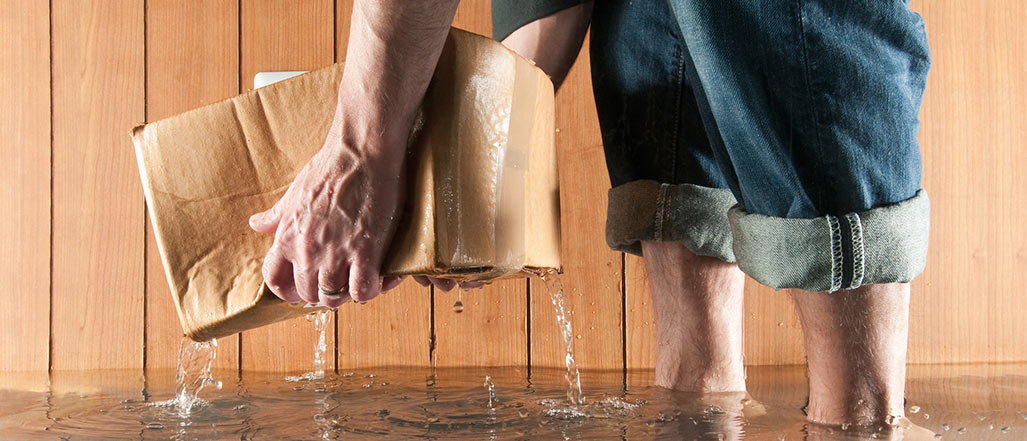Summary
Flood insurance is typically not included in your basic property insurance—homeowners and renters usually must purchase this coverage separately.
- Flood insurance is not generally offered as part of a standard policy because of flood frequency, high risks and high costs
- Flooding can happen in many more areas and regions than people expect—coasts, properties near rivers, lakes or streams, and even places not near bodies of water that have heavy snow accumulation that can melt rapidly
- Because of the risk of damage is high, flood insurance can be expensive
Are you protected if there’s major flooding in your home? You might assume that your basic property insurance covers water damage due to flooding — but often it’s not included. Every homeowner should know the basics of flood insurance, what it may cover, how much it could cost and how you can purchase it. Here’s everything you need to know to stay safe and dry.

What Is Flood Insurance?
Flood insurance covers your property from damage that occurs from rising water. Many types of property insurance — from homeowners insurance to renters insurance to business property insurance — do cover some forms of water damage.
Some examples of water damage that are typically covered include:
- Burst pipes
- Roof leaks
- Rain entering the home because of storm damage
There’s often a catch, though. You may see the words “sudden and accidental” in your insurance policy. This means that if you’ve ignored a slow leak, it won’t be covered. That damage is due to neglect and delayed repairs and wouldn’t meet the definition of “sudden and accidental.”
Flood insurance covers your property from damage that is caused by heavy and prolonged rains, coastal storm surges, melting snow, and levee or dam failures. An insurance rule of thumb is that if the water touches the ground before it damages your property, it’s generally considered flooding and therefore would not be covered by basic property insurance.
Why Isn’t Flooding Covered by Standard Insurance Policies?
Basic property insurance may not cover flood damage for a number of reasons, but the biggest issues are the risk and cost. Consider how many areas across the country may be affected:
- Cities and towns on coasts
- Properties near rivers, lakes, or streams
- Areas with heavy snow accumulation that could melt rapidly
- Places that are usually dry but could be prone to flash flooding during hurricanes
There are many regions of the country that are at risk for flooding, and insurers take this into account.
Next, there is the cost factor. When flood waters rise or breach a levee, they cause property damage across large geographical areas. Furthermore, floods happen too frequently to be considered an acceptable level of risk for insurers.
According to recent testimony provided by a representative of the Federal Emergency Management Agency (FEMA), flood insurance can save homeowners from damages that cost an average of $17 billion per year between 2010 and 2018 (the most recent year that final figures are available).
Why Should I Have Flood Insurance?
One of the most common misunderstandings about flood insurance is that it is only necessary if you live on the coast or in a floodplain. The simple fact is that many properties are vulnerable to flooding, and securing flood insurance is important.
Many homeowners also mistakenly believe they’re protected from flooding associated with a hurricane. This is often incorrect, and it’s important to read your homeowners insurance policy closely to be sure. Although damage done by a hurricane’s wind is covered, flooding resulting from a storm surge or heavy rains might not be.
After surviving the destructive forces of a hurricane, the last thing a homeowner wants to find out is that the rain damage to their home won’t be covered.
Is Flood Insurance Required?
Whether or not you are required to carry flood insurance depends on where you live. FEMA develops maps that show areas at high risk for flooding. Property owners with government-backed mortgages in these areas are required to have flood insurance.
Even if you live outside of a high-risk area, your mortgage lender might still require you to have flood insurance, so be sure to ask if you have the coverage limits you need. Flood zones and community maps are available from FEMA.
How Can I Get Flood Insurance?
Flood insurance is not part of a standard homeowners insurance policy. It must be purchased separately.
Some homeowners who buy flood insurance do so through the National Flood Insurance Program (NFIP). Congress created the NFIP in 1968 in response to private insurers withdrawing from the market, leaving homeowners at risk and dependent upon the federal government to provide disaster assistance after a flood. The NFIP offers coverage in communities that agree to manage and enforce ordinances that reduce flood risks.
However, in 2019 regulators allowed private companies to write flood policies if they meet certain conditions. There are now a number of insurance companies that write flood insurance policies for homeowners.
Why Is Flood Insurance so Expensive?
A number of criteria contribute to the high flood insurance costs. As noted earlier, one major concern is that floods happen often and affect large areas. Especially in recent years, financial damages from floods have soared — and the risk is increasing.
If your home is outside of a flood-prone area, coverage can be relatively affordable. Since flooding is always excluded from a standard homeowners insurance policy, getting extra coverage even if you live outside a high-risk flood zone might be a good idea.
No matter where you live, floods can happen. Drainage systems can become overwhelmed during heavy rainfall, and rapid snow melt in some areas of the country can cause flooding. How much flood insurance costs depends on all of these factors.
Is Flood Insurance Worth the Cost?
When asking this question, it’s important to consider how flood damage occurs. It’s difficult to contain water that rises at a volume and level that enables it to damage a home.
Since your standard home insurance policy will not cover any damage caused by a flood — and floods can damage or destroy an entire level of your home — the peace of mind you’ll get with flood insurance may be well worth the cost.
How Can I Lower the Cost of My Flood Insurance?
While many of the components that go into a flood insurance quote are fixed (such as the location of your home), there are steps you can take to reduce the amount you pay.
The easiest way to reduce your flood insurance premium is to increase your deductible. A deductible is the amount of money you will pay out of your own pocket before your insurance kicks in after a covered event. Increasing your deductible means that you are taking on a bigger financial responsibility after a loss, and an insurer will recognize this by offering you a lower premium.
You may also be able to make improvements to your home that lower your premium. The NFIP recommends elevating utility systems such as heating and cooling systems, water heaters, and electrical panels so that they are less likely to be damaged in a flood.
You can also install flood openings, or if you are in a high-risk flood area, you may want to investigate filling in basements. Basements are now prohibited for new construction in areas with high flood risk, and existing homes within those areas that have basements have a 15% to 20% increase attached to their flood insurance premium.
Sometimes, providing an elevation certificate can result in potential savings on your flood insurance policy. An elevation certificate verifies the elevation of your home relative to the estimated potential height of flood waters in an area at risk of flooding.

The Bottom Line
Flood insurance can be expensive precisely because the risk of flooding is so great. The costs associated with flood damage to homes in the US are expected to increase by more than 60% percent in the next 30 years. That’s a substantial amount, and leaving your home unprotected could result in big financial losses. Take the time to investigate your home’s potential for flooding by reviewing flood insurance rate maps in your area.
Flood damage is rarely minor. As little as an inch of water in a home can cause $25,000 in damage. Even if you don’t live near a body of water there’s a chance your home could be flooded — and the costs of cleanup and repair are substantial. Talk to your agent to make sure you’re protected.
Disclaimer:
All information provided in this publication is for informational and educational purposes only, and in no way is any of the content contained herein to be construed as financial, investment, or legal advice or instruction. Guaranteed Rate Insurance does not guarantee the quality, accuracy, completeness or timelines of the information in this publication. While efforts are made to verify the information provided, the information should not be assumed to be error free. Some information in the publication may have been provided by third parties and has not necessarily been verified by Guaranteed Rate Insurance. Guaranteed Rate Insurance, its affiliates and subsidiaries do not assume any liability for the information contained herein, be it direct, indirect, consequential, special, or exemplary, or other damages whatsoever and howsoever caused, arising out of or in connection with the use of this publication or in reliance on the information, including any personal or pecuniary loss, whether the action is in contract, tort (including negligence) or other tortious action.

